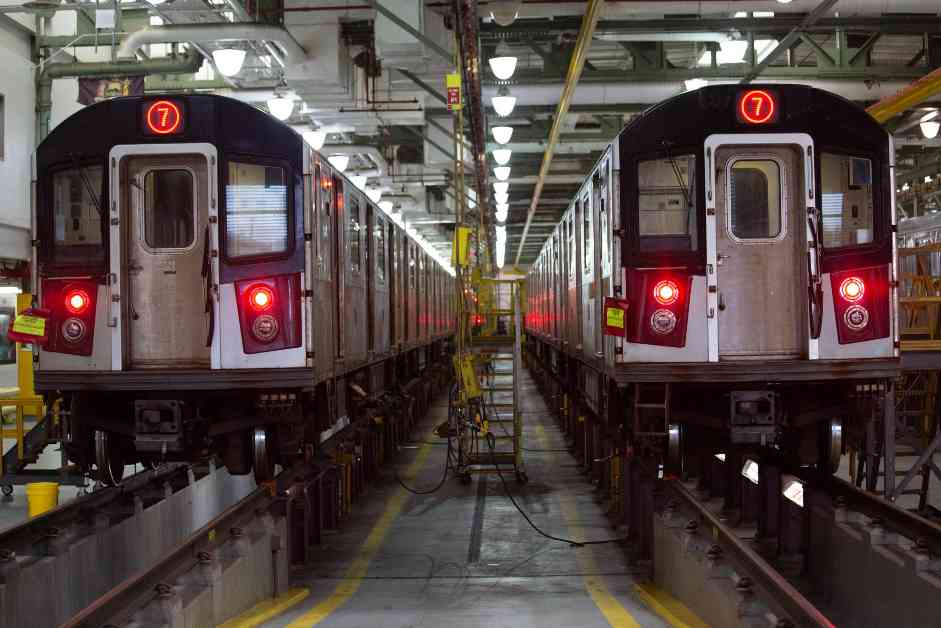The Metropolitan Transportation Authority (MTA) recently announced a groundbreaking $68.4 billion capital improvement program aimed at revitalizing the aging transit system in New York City. Titled “The Future Rides With Us,” the proposed 2025-2029 budget outlines an ambitious plan to address the deteriorating infrastructure of the 120-year-old subway system. With a significant portion of the funding still in question, the MTA faces challenges in securing the necessary resources to implement the extensive investment projects.
Challenges in Funding
Despite the grand vision laid out in the capital plan, nearly half of the projected $68.4 billion budget remains uncertain in terms of funding. This financial uncertainty adds a layer of complexity to the MTA’s efforts to revitalize the transit system and ensure its long-term sustainability. The reliance on funding sources that are not guaranteed poses a significant risk to the successful implementation of the proposed projects.
Andrew Rein, president of the Citizens Budget Commission, emphasized the importance of investing in the unseen infrastructure components of the transit system. He noted that while riders may not directly observe the maintenance of tracks, signals, and electrical systems, these elements are critical to ensuring the safety and reliability of the overall transportation network. The challenge lies in garnering public support for essential but less visible infrastructure improvements that are crucial for the system’s functionality.
Focus on Core Infrastructure
The Citizens Budget Commission, a watchdog group, has urged the MTA to prioritize projects that enhance the regional transportation network’s core infrastructure. By emphasizing the maintenance and improvement of existing assets, the MTA can address the pressing needs of the aging subway system and commuter rail services. This strategic focus on essential infrastructure upgrades aims to prevent a repeat of past crises, such as the infamous “Summer of Hell,” which highlighted the system’s vulnerabilities.
Janno Lieber, the MTA’s chairperson and CEO, underscored the importance of maintaining a high level of investment in the transit system to meet the needs of New Yorkers. With millions of residents relying on the MTA’s services daily, ensuring the system’s reliability and safety is paramount. The proposed capital plan seeks to address critical infrastructure deficiencies and enhance the overall quality of transportation services in the region.
Implications of Congestion Pricing U-Turn
The MTA’s capital plan faces additional challenges due to the unexpected pause in the implementation of congestion pricing by Governor Kathy Hochul. The Manhattan vehicle-tolling plan, which was intended to fund billions in transit improvements, was put on hold, creating a significant budgetary gap in the current five-year capital program. The delay in congestion pricing has forced the MTA to reassess its funding priorities and make difficult decisions regarding project timelines and resource allocation.
President of MTA Construction & Development Jamie Torres-Springer highlighted the impact of the funding uncertainty on critical initiatives such as the Interborough Express expansion project. The proposed light rail line connecting Brooklyn and Queens faces funding challenges, raising concerns about the project’s feasibility without a reliable funding source. The MTA’s ability to advance key expansion projects hinges on securing the necessary financial support to move forward with infrastructure enhancements.
As Governor Hochul considers reinstating congestion pricing with potential modifications, transit advocates emphasize the urgency of addressing the transit system’s pressing needs. Danny Pearlstein, policy director for Riders Alliance, pointed out that adjusting for inflation, the current capital program is smaller than its predecessor, highlighting discrepancies in funding allocations between transit and highway projects. The disparity in investment raises questions about the prioritization of infrastructure improvements and the impact on the overall quality of transportation services in the region.
Investment Priorities
The proposed capital plan allocates significant funding towards purchasing new subway cars and railcars to replace aging vehicles that have been in service since the 1980s. With nearly $11 billion earmarked for the acquisition of 1,500 new subway cars and 500 Long Island Rail Road and Metro-North railcars, the MTA aims to modernize its fleet and enhance passenger comfort and safety. The investment in new rolling stock reflects the agency’s commitment to upgrading essential transit assets and improving the overall rider experience.
In addition to acquiring new train cars, the capital plan includes substantial investments in critical infrastructure projects such as tunnels, bridges, and viaducts. With $9 billion allocated for infrastructure improvements and $7.8 billion earmarked for enhancing structurally unsound station components, the MTA aims to address longstanding maintenance issues and bolster the system’s resilience. By focusing on core infrastructure enhancements, the agency seeks to fortify the transit network and ensure its long-term sustainability.
The MTA’s capital plan also prioritizes accessibility and safety enhancements across the subway and commuter rail systems. With a focus on making stations more inclusive for individuals with disabilities, the agency aims to improve the overall passenger experience and promote equity in transportation access. By addressing critical infrastructure deficiencies and investing in modernization efforts, the MTA seeks to create a more reliable and efficient transit system for all New Yorkers.
In conclusion, the MTA’s ambitious $68.4 billion capital improvement program presents a comprehensive strategy to address the pressing infrastructure needs of the transit system. Despite funding challenges and uncertainties, the agency remains committed to revitalizing the aging subway system and commuter rail services to meet the evolving demands of the region. By prioritizing core infrastructure investments, enhancing accessibility, and modernizing the rolling stock, the MTA aims to create a more resilient and sustainable transportation network for the benefit of all residents and visitors in New York City.


